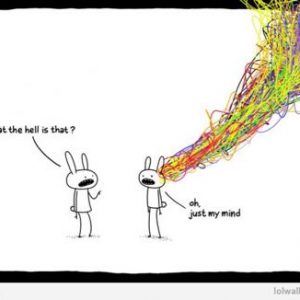 No time to slow down?
No time to slow down?
Q: You talk a lot about the importance of slowing down. But I don’t have time to slow down. I need help clearing fast! How do I effectively use your programs when I need to tackle things more quickly?
SBV: “Tackle” is not where it’s at with this work. And you cannot rush letting go. Sorry. We need to go slow to go fast. If this seems contradictory, let me explain: We cannot release stress and clutter when we are in a constant state of alert and overwhelm. Sure, you can go on a clearing binge of your living spaces and see where it gets you. In the end you might discover that fast-tracking works against you. It won’t make a dent on clearing the patterns and habits that got you stuck in the first place…
nor lead to lasting change.
The Brain
You can blame the brain.
You see, every time you feel overwhelmed, it means that an ancient part of the brain, called the amygdala, has been activated. This is the part of the brain that goes into fight-flight-or-freeze. When fight-or-flight is triggered, it floods the body with stress chemicals. Once these chemicals are unleashed, overwhelm has hijacked you. It has taken over your life (and biochemistry), and won’t let you go easily.
Here’s the good news: While you cannot shut off the lizard brain that goes into fight-or-flight, you can manage it. You can reduce the cascading effect of stress by slowing down and simplifying; by reducing a task and repeating it; by dialing back on the activity that is causing the overwhelm in the first place.
As Dr. Robert Maurer writes in his excellent little book, One Small Step Can Change Your Life:
“Small, easily achievable goals — such as picking up and storing just one paper clip on a chronically messy desk — let you tiptoe right past the amygdala, keeping it asleep and unable to set off alarm bells. As your small steps continue and your cortex starts working, the brain begins to create “software” for your desired change, actually laying down new nerve pathways and building new habits.”
Why stress yourself out when you could choose ease instead?
Small steps, big changes
Taking smaller steps may not feel very effective or satisfying at first, but if you stick with them they will work their magic to calm the nervous system, charm the part of the mind that gets rattled, and rewire the brain to grow new habits that last. Whether it takes you three days or three weeks to bring your fridge into the clear, or manage the insanity in your closet, you won’t care because of how good you feel when you invite ease into your practice.
In the end, it’s not how much you can cram in a shorter time frame, but how much ease and spaciousness you can bring to the experience.
It’s a quality of being––not quantity––that will change your life forever.
So next time you’re feeling overwhelmed, take it as a sign that you’ve stepped into the red zone. Use it as a memo to self to dial it back. And keep repeating until it becomes second nature.
Where to begin… and keep going
If you could use a more directed approach to clearing, I have made it easy for you: I have mapped out a simple 3-step pathway using my books and courses as a guide. This pathway is called the Spacious Way.
Whether you prefer to clear on your own or as part of a “clearing circle” book group, this guided approach will give you an easeful and lasting way to play a much bigger game. You can CHECK IT OUT HERE.
Consistency is key
Whatever approach you end up taking, my advice would be this: Follow the books and/or courses as they were designed. Do the exercises. Only think about today. Take it one step at a time and allow the process to work its magic.
Before you even realize it, you will have lightened your load in less time. You will have released more stress and stuff than you ever imagined possible.
This 3-STEP PATH can lead the way.




